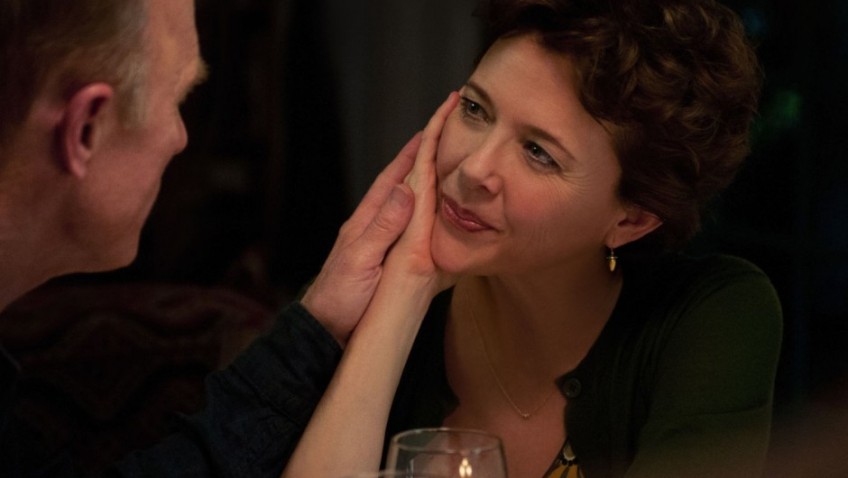There is a good film lying beneath Arie Posin’s interesting and well-acted film, The Face of Love, but it might be for another writer/director to unearth it. From the first cheesy opening scene on a Mexican beach resort, there is something wrong with the inconsistent tone of the film that seems to clash with the premise’s psychological depths. Ed Harris and the wonderful Annette Bening – who is, quite literally, the Face of Love – are good enough to keep us watching, but their efforts are never enough to make the film a satisfying experience.
In the nearly silent montage that opens the film, we see a fifty-something couple who are madly in love. Nikki (Bening) has had the perfect marriage to Garret (Harris), a handsome architect with whom she is enjoying a holiday tryst in a Mexican resort. You know it is too good to be true and sure enough, within three minutes, Tom drowns. The beach is mysteriously empty and so it is Nikki who finds his body: conveniently washed up right in front of their beach front hotel. There is no explanation to how he drowned.
Five years later, Nikki is still drifting. Her neighbour, and former friend to Nikki and Garret, Hoger (the late Robin Williams), has little hope marrying the woman he has secretly loved. Nikki does not even date. And she no longer goes to the Los Angeles Art Museum where she and Garret used to go.
But one day she changes her mind and sees a man who looks exactly like Garret. She returns to the museum until she sees him again and then stalks him. She learns that he works at a university and she pays an awkward visit his art class. Inventing an excuse to see him again, Nikki enquires about private lessons, eventually inviting Tom over. Tom, bemused but intrigued and flattered, finds himself falling for this slightly odd, but passionate woman. Conveniently, Tom is divorced, and his ex-wife supports his art.
When Nikki and Garret’s only child, Summer (Jess Weixler) returns home from university without notice and sees Tom, she becomes hysterical, ordering him to leave. Nikki asks her to leave instead and smoothes things over with Tom. The stress of trying to hide her lover from her social circle eventually leads to cracks in the relationship as half of Nikki is aware of her fantasy while the other half wants to seek comfort in the delusion. The dramatic climax comes when Nikki persuades Tom to join her for a tryst in Mexico. In the all-too-neat denouement, we see Tom’s painting, The Face of Love, in a gallery.
You do not have to be a budding Roger Ebert or Philip French to know that this is Hitchcock’s Vertigo in reverse, complete with the art museum as the place where the jaded protagonist spots the person who resembles a past lover. This, and Robin Williams in his psychological thriller – as opposed to friendly comic – mode, wants The Face of Love to be the psychological thriller it never quite manages to become.
In One Hour Photo, Williams played a sad, lonely, photo technician who becomes dangerously obsessed with the happy family whose photos he develops. In Christopher Nolan’s Insomnia, Williams plays a creepy crime writer who plays cat and mouse games with the detective as the prime suspect in the murder of a school girl. Williams is in this ‘sinister creep’ mode throughout The Face of Love, spying on Nikki rather than simply looking out for her. He lurks around like a bottled-up explosion and you are always waiting for something to happen to explain or justify the character.
The tone of the film is at odds with our expectations as The Face of Love sails along as a straightforward, even sentimental, profile of bereavement at its most intense. That Bening pulls it off is a miracle. The film’s entertainment value is down to the chemistry between the leads and the skill of the cast.
Bening, whose expressive eyes and face convey all of Nikki’s conflicted feelings, gets to the heart of her complex character, and her performance remains laudable, where it could so easily be laughable. Harris, sexy, sincere, bemused, wary, yet seduced and willing to go for it is equally credible. That Harris’ Tom is so willing to go for it is down to a convenient secret he that only his ex-wife knows.
To Posin’s credit, he gives meaty, sexual roles to fifty-something actors who might otherwise find themselves playing the drab mother and father respectively of children who are the stars of the film. You just wish that Posin had the vision and skill to match the performances.
Joyce Glasser – MT film reviewer




